April 2020
Kristin Quigley Russell
Group Fitness Instructor
As we are all adjusting to a new normal of distance learning from home, I have a few tips to share with parents. I am a special education teacher with over 20 years of experience working in the education system. I have also been a dancer my entire life and a dance and fitness instructor at The Connection for 20 years. However, I am also a mom to two boys (4 & 6) who we are now learning to incorporate distance learning at home.
In addition to having a dedicated workspace and realistic schedule, there is also a need for children to take “brain breaks” and keep moving. In our house, we  have incorporated them into our schedule between “classes” or activities. Here are some of our personal favorites, especially when we cannot get outside.
have incorporated them into our schedule between “classes” or activities. Here are some of our personal favorites, especially when we cannot get outside.
Freeze Dance Games (incorporates coordination, balance, listening skills, following directions and movement): We all know and love Freeze Dance and as a lifelong dancer and dance instructor…I utilize this a LOT! Just play your favorite tunes, dance around and freeze when the music stops. Easy & fun! However, this can get redundant. If you need to “change it up” a bit, give these variations a try.
Emotions/Feelings Freeze Dance (incorporates Social-Emotional Learning/Acting): Before each time you put the music on, tell your child(ren) an emotion to
dance like such as happy, sad, angry, frustrated, proud, tired, excited, surprised, etc. When the music stops they still freeze with that emotion. Before you start the music again, you simply pick a new emotion.
Alphabet Freeze Dance (incorporates letter/sound identification): For this game, before you start the music in each round give your child a letter (or a letter sound for more of a challenge) to freeze like. They then dance however they would like and when the music stops, they must freeze in the shape of that letter. Change up

Alphabet Freeze Dance
the letter each time. You can use the letters to spell out a word that they have to figure out too! You can choose to use upper case, lower case or both letters!
Animal Freeze Dance (incorporates animal recognition/Acting): For this game, you will play similarly to Emotions/Feelings Freeze Dance but instead of acting out emotions, you will ask your child to act as though they are different animals. They can make the animal sounds and movements. You can choose to pick animals from one region/category and ask your child to guess what it was such as African Animals, Sea Animals, Farm Animals, etc. for more of a challenge.
Simon Says/Follow the Leader (incorporates following directions, problem solving listening skills, coordination, balance and movement): One person is “Simon” (but you can call this person anything you’d like) the other person or people follow along. “Simon” tells the others what to do such as “Simon Says jump up and down, Simon Says touch your toes, Simon Says jog in place, etc. Simon can do the movements along with the others or not and try to trick them! At some point “Simon” will say something like “run in place” (but not say Simon Says)…this is how you “trick” the others. If they do the movement you say (and/or do) they were tricked! Try with harder movements. Take turns being allowing your child(ren) to be Simon as well as the follower.
Yoga/Breathing (incorporates mindfulness, relaxation, following directions, coordination and balance): Incorporating any kind of children’s yoga is a great way to incorporate movement in between transitions and/or at the start or end of your day. A Google search may help you with incorporating poses into stories with animals that younger children would enjoy. Also incorporating breath is also important. Try using something like a pinwheel, scarf, feather or tissue. Instru

Doing yoga for a brain break
ct your child to “see” the effects of their breath. If they blow hard what happens? Soft? How long can they keep the pinwheel moving/tissue in the air? Using props like these will help a younger child “visualize” and concentrate on their breathing.
Graduated Counting Calisthenics (incorporates movement, strength, balance, following directions, focus, patterning/pre-algebra and counting skills): Instead of just asking your child to run in place or do 10 jumping jacks, give your child a pattern such as jumping jack, pushup, turnaround (you can make these combinations shorter or longer). Your child will then have to do a set of this pattern ONE time each, then TWO times each, then THREE times each, etc., or the reverse, start at 10 and work down to 1. For example, they would do one jumping jack followed by one push up and then turn around once. Then, on round two they will do TWO jumping jacks, TWO push-ups and turn around TWICE. Then repeat three times each, then four, etc. This is just a fun way to incorporate movement in a different way.
Melting (incorporates imagination, relaxation, mindfulness and following directions): If you child is worried or “stressed out” try this melting activity with them. Ask them to pretend they are an ice cube. Talk about that an ice cube is hard and doesn’t move. Ask them to “tighten up” like an ice cube, talk about finding all the areas of their body to tight up. Then tell them to imagine the warm sun comes out and they slowly melt into a puddle of water. First their head melts (or relaxes), their eyes, mouth, chin, then their neck, hands, arms, tummy, back, legs, feet, etc. Once they are fully “melted,” ask them to check to see if any areas have not yet melted and focus on melting them (or relaxing them). Try this again! Be sure to calmly talk them through it.
These are just a few of the common movement/brain breaks we take in my house throughout the day. Many of these are also great for you parents to incorporate as well! Give them a try. Use them for inspiration. What creative ways do you incorporate into your new “home-school day “to keep moving? What brain breaks do your children enjoy?
